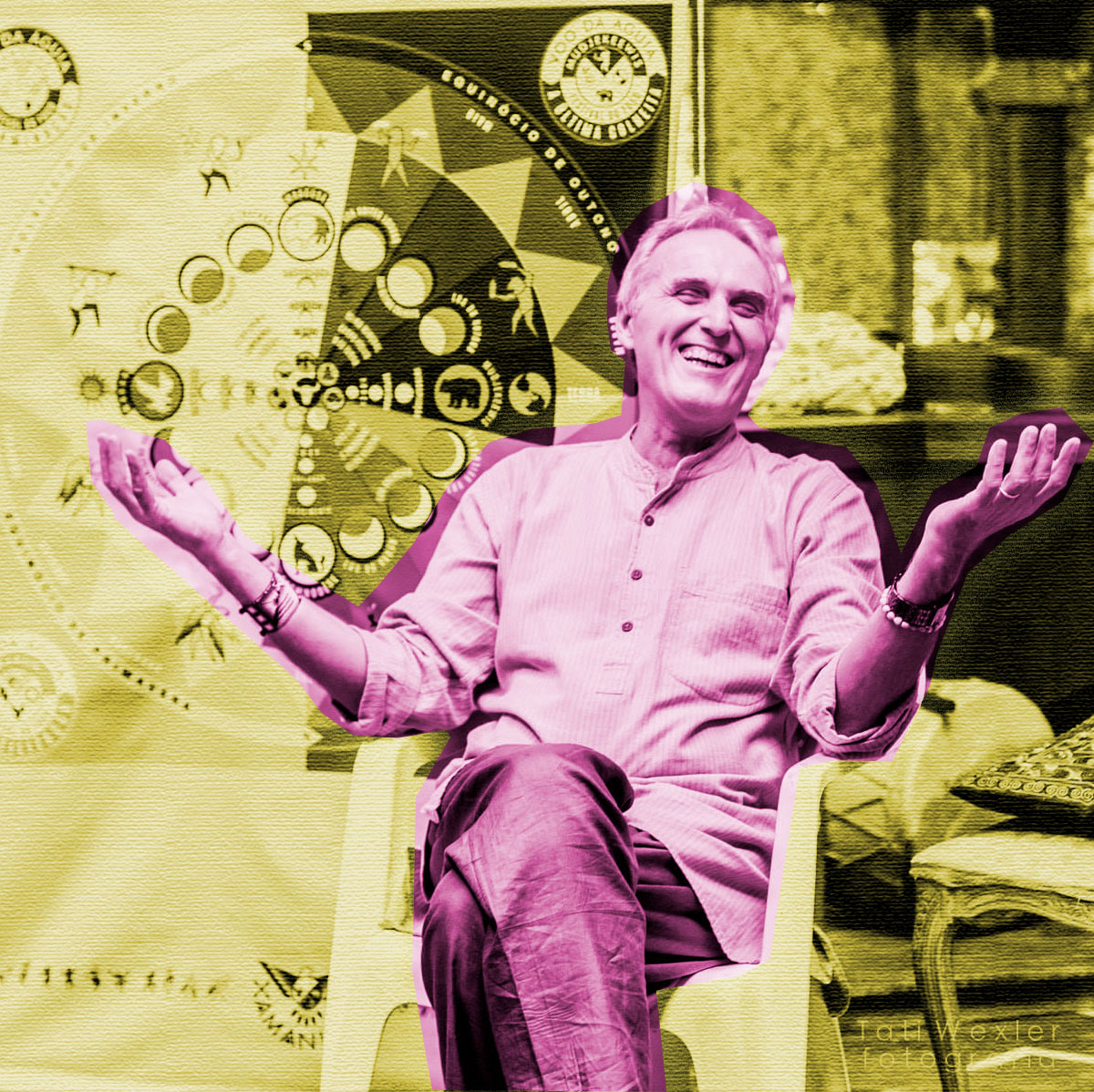Leo Artese is a free radical within the Santo Daime church. While he follows the official calendar and the original design bequeathed by godfather Sebastian, he also sings his own hymnbooks (‘O Curandeiro’ and ‘Camino das Virtudes’), and performs a powerful shamanic ritual (‘Voo de aguila’), unheard of within the daimist liturgy: “I was a shaman before I was a daimist, just as others are engineers or teachers”, Artese justifies himself during this interview we had in Ibiza as part of his annual European tour.
Besides being a shaman, Artese is a qualified musician and has ‘received’ immortal hymns from the astral, such as ‘Yemanjá’ or ‘Livre’. Leo guides his ‘trabalhos’ by playing the bongos and imbuing the rituals with rhythm and good humour.
I would like to ask you about the political situation in Brazil, as ecology and politics cannot be separated in your country.
The political situation is very complicated today. We have a conservative government, which is basically supported by three ‘benches’, the BBB: the ‘Buoi’ bench, which is the agricultural industry; the Bible, which is the evangelists, the neo-Pentecostals, and ‘Bala’, the arms manufacturers. Today, for example, thanks to this lobby, any Brazilian has the right to buy a gun, which is something that has never happened before in Brazil.
So it is a government that is dangerous for people who are linked to shamanism, forest medicine and all the New Age practices.
Why?
Because there is no legalisation of ayahuasca in Brazil. Right now, its use is supported by the resolution of a multidisciplinary working group, called Conad (National Anti-Drug Council). This resolution is what allows us to work with ayahuasca, but difficulties can arise at any time. This is directly related to the legitimacy of its use in ayahuasca institutions that use ayahuasca as part of their religion, it is a sacrament. For the Indians, ayahuasca is a cultural heritage… but it is also not expressly protected by law. The political scenario is not the best, but at least they don’t bother us; we are free to do our work and ceremonies, although there is always a certain shadow lurking…

Bolsonaro’s government has been disastrous for the forest and its people, the original inhabitants of Brazil.
Exactly. Mainly, if we look at the ecological part, there has never been such devastation. Bolsonaro did away with bodies that carried out security checks in the jungle.
Everything points to the fact that there will not be a second Bolsonaro term.
Well… that’s what I hope. He is an ex-military man, he has completely conservative ideas, dangerous and aggressive ideas… towards women, towards homosexuals, towards black people. With such a government it is very difficult to enter a new era, a new consciousness. The country is waiting for another president, another Brazilian who is able to respond to the needs, especially of the poorest, and not only to the needs of the privileged.
The forces behind Bolsonaro’s government – loggers, farmers – believe that the land occupied by the original settlers – a vast territory of Brazil for a meagre 2% of the population – should be exploited to fuel economic growth. Is this the case?
Yes, they do. They want mining, logging and agricultural companies to exploit the Amazon rainforest, and it’s going to get worse than it already is. What is happening in the Amazon is unbelievable.
Human beings have to decide whether they want to eat meat or whether they want the Amazon to remain a forest, because those who are destroying the Amazon are not so much the loggers, but the farmers, who are turning the forest into pasture for cattle. So people have to consider changing their eating habits: we have to become vegans or vegetarians.
So is there a direct link between what we eat and the destruction of the Amazon?
Of course there is. As humanity, we have to make a decision in this sense, because the forest is going to disappear… the main trees, the ¡’queimadas’ [arson] that are being carried out, it’s unbelievable.
You are linked to the Santo Daime, whose main church is in Mapiá, in the state of Acre. Do you maintain links with the indigenous communities?
Many links. I have been working with shamanism for many years, and we have a shamanic alliance in Brazil, with the Indians, and also in other parts of the world, like here [Europe], it is an alliance for the study of shamanic practices, it is what we call ‘Universal Shamanism’. I am linked to the Amazon through godfather Sebastian, godfather Alfredo, and I have friends on many different lines.

How is your relationship with them in these troubled times?
In the last two years we have been quite far apart because of the pandemic, but our coexistence has always been very friendly. With the traditional peoples we have networks of friendship and common work around shamanism and spiritual work. We also have the legacy of a Brazilian shamanism meeting that we do almost every year, where we practice traditional shamanism, neo-shamanism, universal shamanism, we sing music, scientists and psychiatrists come… everything is part of our studies.
However, from the Western/Cartesian point of view, shamanism would be little more than a superstition…
That is changing, consciousness is opening up. Today there are many scientists looking into shamanism. I myself have friends who are psychiatrists and psychologists who go to shamanic ‘trabalhos’ or even conduct ‘trabalhos’.
There is a traditional shamanism, which comes from the original peoples, in which the transmission is generally carried out in a family way or through a whole experience that involves the community: the rites of passage, the initiations, the preparations… which are being lost little by little because the young people in the villages have the mobile phone, they are in contact with the world, and they are increasingly reluctant to go through these initiations. The result of this acculturation is that the tradition is being lost as young people are no longer interested in following it.
But this traditional shamanism has been coexisting for several decades with a neo-shamanism that was created by Michael Harner*, an American, who initially went through traditional shamanism but was able to adapt these practices to urban life.
To summarise a lot, I would say that universal shamanism tries to reconcile traditional shamanism with neo-shamanism. There is a lot of confusion and misinformation about shamanism, shamanism is a transformative act, shamanism heals. Another thing is ‘showmanism’, where people pretend to do a lot of things but nothing happens to them. That is trivialisation, it is not shamanism.
What can shamanism heal?
Shamanism works on four bodies: physical, mental, emotional and spiritual. For each of these four bodies it has specific tools, because shamanism is systemic: the cure can start in the body, in the mind… it can have an allopathic effect when working with medicines, and also a spiritual effect when working with healing entities or with the elements of Nature. It is magic, but it is not Harry Potter magic.
You are a free radical within the Santo Daime: you have your own hymnal and incorporate the shamanic element, which is not so common within this cult.
I don’t think so either. There are other centres that also work with the Red Way. We are in a time of alliances: the Santo Daime has an alliance with the Red Way. I consider myself a representative of universal shamanism, not Brazil, not Santo Daime. I worked in shamanism before I met the Santo Daime; the Santo Daime increased my potential, then I became famous and founded a church [Ceu da Lua Cheia]. Santo Daime is my religion
It is a church that is not in the city but in the forest, 20 hectares of Atlantic forest, 45 minutes from Sao Paulo, we have a circular church, a jagube and rainha plantation, so we keep walking to be self-sustainable, to make our own sacrament.
Besides the Santo Daime, my main activity is shamanism. Just as other daimistas are engineers, therapists, or teachers, I work with shamanism.
Why is this tour you are doing in America and Europe important?
This tour is part of my mission! I feel that my mission is to inspire people, not to save the world but to inspire people to have a better life, whether through Santo Daime, shamanism or any other tool. We have created an alliance (IAUSH) International Alliance of Universal Shamanism. An alliance of the heart.

How important is the ayahuasca drink within shamanism?
It is the great expander of consciousness, without a doubt. A fundamental element of shamanic work is to use expanded states of consciousness, that is what differentiates shamanism from other practices. We work with fire, with the Medicine Wheel and with other elements that allow us to reach other expanded states of consciousness, to reach what is nothing more than the original state of the soul.
The world we live in usually has to do with fulfilling the laws of a state, but the one more in line with the original spirit of the soul is what Castaneda calls ‘Nagual’. It is fundamental that you can search for parts of yourself through expanded states of consciousness that you do not have access to during ordinary consciousness.
In that state you can connect maybe with sacred geometry, mandalas, you can balance the spiritual body, or maybe you see the screw-ups you’ve made in life, and become aware of them, or people maybe get in touch with the enchanted world or divinities, or connect with environmental consciousness, become aware that Nature is alive. There are many levels: there are people who increase their artistic ability, their auditory acuity, and there are people who enter a state that is difficult to describe in words but which we could describe as Buddhist emptiness. It is a state in which you have no fear of death, no excess of joy or sadness, but serenity and a feeling of being integrated with the whole Universe. It is a moment when the ego fragments into tiny particles… when a person enters this state, he or she is never the same person again.
One last question: what is the process of receiving a hymn, such as Iemanyá, is it true that the hymns are in a ‘library’ in the astral that one connects to through the ‘daime’?
You can enter that sacred dimension in a symbolic way. The library for me is a symbol, but in essence what happens is a channeling, a mediumistic inspiration in which you receive the song and also the lyrics…. I listen in my head and it sounds the same as I am listening to your voice now… everyone has their own way of connecting. Some people see things, and I listen to music.
*Michael Harner, author of ‘The Way of the Shaman: a Guide to Power and Healing’ (1980).
More about Leo Artese in Xamanismo and in his social networks.